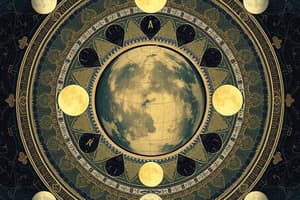Podcast
Questions and Answers
What evidence does a lunar eclipse provide regarding the shape of Earth?
What evidence does a lunar eclipse provide regarding the shape of Earth?
- Demonstration of Earth's stationary position
- Evidence of Earth's flatness
- Evidence that the Moon is larger than Earth
- Curved shadow indicating a spherical Earth (correct)
How did Eratosthenes measure the size of Earth?
How did Eratosthenes measure the size of Earth?
- By counting the number of stars visible from different locations
- By calculating the distance between Earth and the Sun
- By directly measuring Earth's diameter with a long tape
- By observing the angle of the Sun's rays at different locations (correct)
What is the significance of the angle observed by Eratosthenes between Syene and Alexandria?
What is the significance of the angle observed by Eratosthenes between Syene and Alexandria?
- It proves the Earth's rotation speed
- It shows the curvature of the Earth over a distance (correct)
- It demonstrates the effect of the Moon's gravitational pull
- It indicates that Alexandria is farther from Earth's equator
What changes in the north celestial pole's location over thousands of years?
What changes in the north celestial pole's location over thousands of years?
What is the purpose of the epicycles and deferents in Greek astronomy?
What is the purpose of the epicycles and deferents in Greek astronomy?
Which star was nearest to the north celestial pole about 5000 years ago?
Which star was nearest to the north celestial pole about 5000 years ago?
What misconception did the Greeks hold about celestial movements?
What misconception did the Greeks hold about celestial movements?
What will happen to the north celestial pole in 14,000 years?
What will happen to the north celestial pole in 14,000 years?
Which ancient culture developed a calendar based on a 365-day year?
Which ancient culture developed a calendar based on a 365-day year?
What astronomical phenomenon did the Egyptians track to correspond with the flooding of the Nile River?
What astronomical phenomenon did the Egyptians track to correspond with the flooding of the Nile River?
Which group made astronomical observations involving 'guest stars'?
Which group made astronomical observations involving 'guest stars'?
What was the primary purpose of the stone circles built by ancient Britons?
What was the primary purpose of the stone circles built by ancient Britons?
What did the Mayans base their sophisticated calendar on?
What did the Mayans base their sophisticated calendar on?
What did ancient cultures rely on before the invention of telescopes?
What did ancient cultures rely on before the invention of telescopes?
What concept about Earth was established by educated people in the eastern Mediterranean region over 2000 years ago?
What concept about Earth was established by educated people in the eastern Mediterranean region over 2000 years ago?
What philosophical view did a philosopher from 2500 years ago suggest regarding Earth?
What philosophical view did a philosopher from 2500 years ago suggest regarding Earth?
Flashcards are hidden until you start studying
Study Notes
Lunar Eclipse
- A lunar eclipse occurs when the Moon moves into and out of Earth’s shadow.
- The curved shape of the shadow is evidence that Earth is a sphere.
Earth's Size
- Eratosthenes measured the size of Earth by observing the angle at which the Sun's rays hit our planet's surface.
- The Sun's rays are parallel, but since Earth’s surface curves, the rays hit at different angles at different locations.
- The difference in angles allowed Eratosthenes to calculate Earth’s circumference.
Earth's Wobble
- Earth’s axis wobbles in a 26,000-year cycle.
- The north celestial pole is currently near the star Polaris.
- About 5,000 years ago, the north celestial pole was near Thuban, and in 14,000 years, it will be closest to Vega.
Retrograde Motion
- The apparent backward motion of planets against the background stars is called retrograde motion.
- This phenomenon can be explained by the relative motions of Earth and the other planets as they orbit the Sun.
Geocentric Model
- The Greeks believed that Earth was stationary and that all sky motions were circular.
- To explain the observed motions of the planets, they developed a complex model involving epicycles and deferents.
Ancient Astronomy
- Many ancient cultures developed sophisticated systems for observing and interpreting the sky.
- The Egyptians of 3,000 years ago adopted a calendar based on a 365-day year, and they kept track of the rising time of the bright star Sirius.
- The Chinese also had a working calendar and recorded comets, bright meteors, and dark spots on the Sun.
- The Mayans developed a sophisticated calendar based on the planet Venus and made astronomical observations.
- The Polynesians used the stars to navigate over long distances.
- In Britain, ancient people used stones to track the motions of the Sun and Moon, and we still find these stone circles.
Cosmology
- Our concept of the cosmos is called cosmology.
- Before telescopes, humans relied on their senses to understand the universe.
- Ancient civilizations developed cosmologies that combined their observations of the heavens with philosophical and religious beliefs.
Spherical Earth
- At least 2,000 years before Columbus, educated people in the eastern Mediterranean region knew Earth was round.
- The concept may have originated with the Greek philosopher and mathematician Pythagoras.
Studying That Suits You
Use AI to generate personalized quizzes and flashcards to suit your learning preferences.



